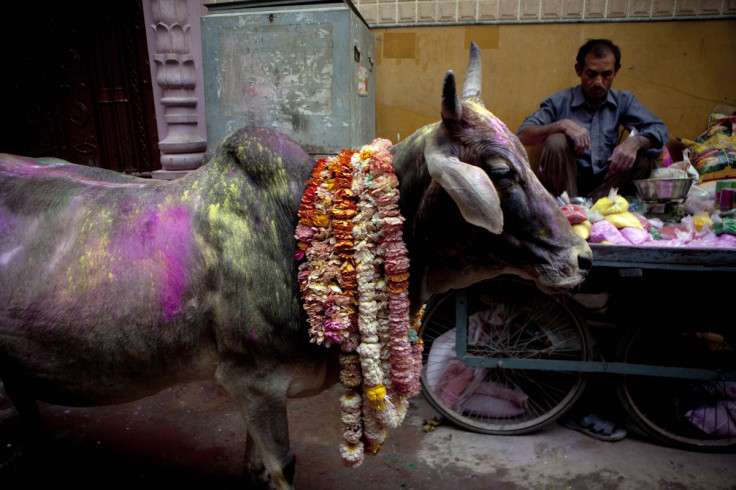Holi 2016: How to keep pet animals safe while celebrating the Indian festival of colours

On 24 March India will celebrate one of its most popular festivals, Holi. Dubbed the "festival of colours", people take to the streets to indulge in a giant water fight with coloured powder and paint.
While the festival is seen as one of the most enjoyable days of the year, many have begun to question the impact Holi has on India's animals, who are often caught up in the festivities unaware. Animals rights activists have issued notices about the ill-effects Holi colours can have on animals.
Nikunj Sharma, government affairs liaison for People for the Ethical Treatment of Animals (Peta) India, told IBTimes UK: "The powders that are used during Holi often contain toxic metals or dyes that can cause skin allergies, rashes or even blindness in animals. There are more and more compassionate people everywhere who care for animals, but nevertheless, awareness is required at the community level to ensure animals do not get hurt."
Sharma explained that animals can easily inhale the Holi coloured powder, which often leads to nasal irritation and respiratory allergies, as well as infections. These colours are also known to cause hair loss and dermatitis in dogs.
Additionally, animals that happen to ingest the colourings can suffer from stomach ailments or other illnesses leading to death. In order to avoid this, IBTimes UK rounds up some of the things you can do to keep animals safe during the Holi celebrations this year.
1. Spread awareness in your local community
Sharma says: "Housing associations or building managers should put up notices that remind the residents to keep their animal companions indoors during Holi and to never throw the powder or water balloons at animals."
If your management doesn't do this, you can take initiative and spread the word among your neighbours and friends. Start by sharing this article with those you know who are pet owners.
Sharma added: "People should also watch out for community dogs and strays, and put up notices in their buildings asking people not to harm animals with colour water."

2. Use natural colours instead of ones from the store
Animal rights campaigners have frequently pointed out the hazardous nature of the dry powder colours available in stores during Holi. The Humane Society of India notes that not only do dogs get paranoid when colours are rubbed on them, but they also tend to lick their body, and this often becomes a main source of poisoning.
A spokesperson for the Humane Society said: "The presence of lead [in colours], which acts as an accumulative poison, makes these colours a high-risk material for pets. Pets can get severe infection if they are hit by coloured water balloons."
An easy way to combat this is to make your own natural Holi colours at home this year. IBTimes UK has compiled some of the ways to use homemade products for your coloured powders.
3. Keep Holi sweets out of animals' reach
While colours are usually the main focus when it comes to animal safety during Holi, animal campaigners have also warned about the danger of Holi sweets. Since most pets are allergic to sweets and sugar, they could be just as harmful as the Holi colours.
The Humane Society noted: "Make sure your guests or children do not offer sweets to your pet. Similarly, fried or high-calorie foods do not go well with their digestive system."
4. Removing colour from animals
Kerosene, alcohol and hair oil should never be used to remove Holi colours from pets. Instead, organisations like Peta and the Humane Society recommend using animal-friendly shampoo.
This should get the colours out of their fur. However, if irritation persists then pet owners are urged to seek medical care. Those washing the animals should also wash their eyes in case any colour has gotten inside.
5. Look out for warning signs
In the case of animals being severely affected by the Holi colours, there are warning signs that you can stay on alert for. The Humane Society notes that symptoms of poisoning from Holi colours in pets include:
- Excessive salivation
- Vomiting
- Loose motions
- Behavioural changes like aggression of stupor
Pets must be taken to a vet immediately if any of the above signs are observed.
© Copyright IBTimes 2025. All rights reserved.




















